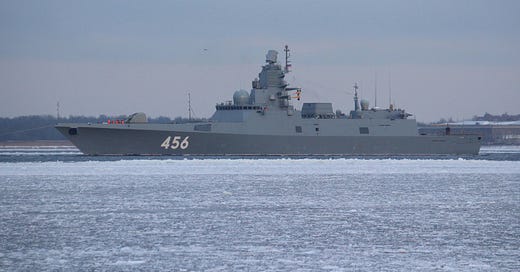Russia's latest Zircon capable warship completes missile certification trials
Russian Navy missile frigate “Admiral Golovko” completed missile certification trials in August 2024 but crucially, no Zircon certification firing was observed.
Russian Navy Northern Fleet Project.22350 class guided missile frigate SKR-456 “Admiral Golovko” highly likely completed its long overdue Oniks (NATO: SS-N-26) & Kalibr (NATO: SS-N-27/30) missile integration and certification programme in the White Sea and returned to homeport Severomorsk.

Admiral Golovko was commissioned into the Russian Navy on 25 December 2023 and arrived in her permanent homeport of Severomorsk on 11 January 2024 where she remained largely inactive until transiting to the White Sea port of Severodvinsk in late May to begin preparations for missile firing trials.
The firing programme, which began in on the White Sea ranges on 17 July 2024, was staged over five rounds and carried out exclusively in announced maritime closure (PRIP) and airspace closure (NOTAM) areas covering Dvina Bay, the Gorlo Strait and the north west sector of Mezen Bay to Chiza. The last firing event took place on 18 August 2024.
The nature of the PRIPs suggests waypoint firing in a SW-NE orientation from southern Dvina Bay towards littoral and/or land-based static targets located in the Chiza area using Oniks and Kalibr class weapons. Importantly, none of the firings in the five-round programme are assessed to have been conducted using the Zircon (NATO: SS-N-33) class hypersonic missile for which the Pr.22350 are widely reported as capable of firing.

A successful test firing programme is a key milestone in Admiral Golovko reaching full operational status and upon Golovko successfully completing K2/K3 maritime training, it is assessed Russia will highly likely be able deploy three Pr.22350 class missile frigates by December 2024. Even without Zircon missile capability, this greatly increases Russia’s ability to project power globally and allows maintenance cycles on deployed frontline warships to be carried out.
This has been a particular problem in the Levant region where Black Sea Fleet Pr.11356 frigate “Admiral Grigorovich”, Pr.20380 Steregushchiy class missile corvette SKR-734 “Merkuriy” and Pr.21631 Buyan-M class missile corvette MRK-626 “Orekhovo-Zuyevo” have been deployed as the standing maritime combatants since 2022. MRK-626 returned to the Baltic Sea for a maintenance cycle on 25 May leaving a capability gap that was only filled by the arrival of Northern Fleet Pr.22350 SKR-454 “Admiral Gorshkov” into the Mediterranean Sea on 24 July.
SKR-454 Admiral Gorshkov cannot remain deployed in Tartus indefinitely and will need a relief if Russia is to maintain a robust offensive capability in the Levant region. Once operationally certified Russia could deploy either Admiral Golovko or Admiral Kasatanov as a replacement and if desired, maintain a continuous Pr.23500 missile frigate presence in the Mediterranean Sea region which is a comparable presence to all NATO nations with the exception of the United States.

Importantly, a fully operational Admiral Golovko reduces the burden on the older Northern Fleet Kirov, Slava, Udaloy & Sovremenny class warships allowing those vessels to undertake maintenance cycles and/or conduct regional security operations in the North Atlantic, Norwegian Sea, Barents Sea and along the Northern Sea route, a waterway of key strategic importance for Russia and its allies. Russia now has more flexibility to increase its Naval presence in the Arctic region at a time when Western nations are beginning to operate more readily in this space.
Finally, it is important to stress that while lead vessel of the Pr.22350 class SKR-454 Admiral Gorshkov may have fired Zircon missiles during her missile integration programme in the White Sea during 2022, and could have deployed fitted with Zircon missiles, follow-on units of the class, SKR-461 Admiral Kasatanov and SKR-456 Admiral Golovko have almost certainly not conducted Zircon missile integration trials and are assessed as not certified to launch this weapon. Nevertheless, both warships, with their Oniks and Kalibr systems, remain formidable maritime adversaries.




